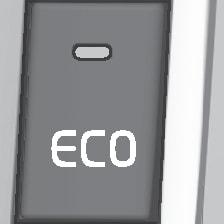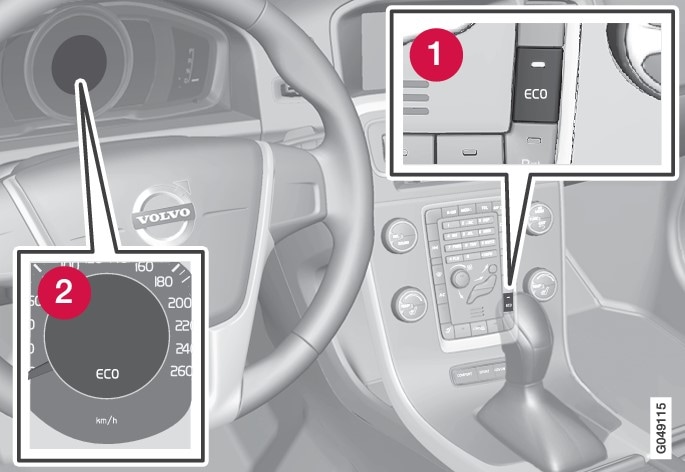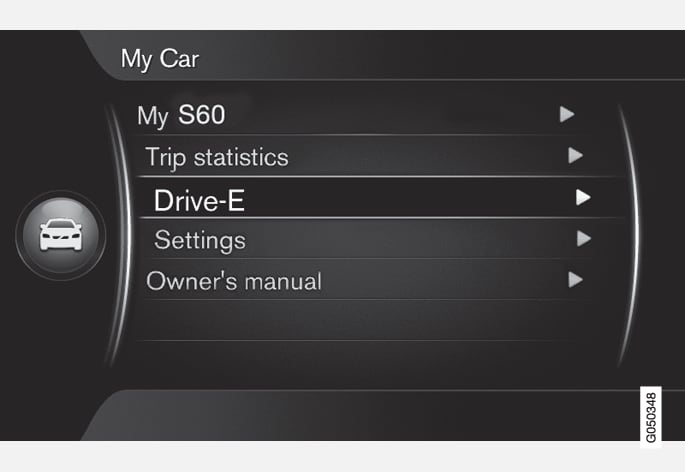Introduction

When Eco is activated, the following functions are modified:
- The automatic transmission's shifting points
- The engine management system and accelerator pedal response
- Stop/stop function (Start/Stop – introduction): the engine can auto-stop before the vehicle has come to a full stop
- Eco Coast functionality is activated: engine braking is disabled
- Climate system settings: certain functions (e.g., air conditioning) will be temporarily reduced or deactivated
Note
When Eco is activated, several climate system parameters are changed and the function of certain current-consuming systems will be reduced.
Some of these functions can be restarted manually but full functionality will not be restored until Eco is deactivated.
Function

 ECO On/Off button in the center console
ECO On/Off button in the center console ECO symbol in the instrument panel
ECO symbol in the instrument panel
When the engine is switched off, ECO is deactivated and must be reactivated each time the engine is started (with the exception of certain engines).
The ECO symbol will be displayed in the instrument panel and the indicator light in the ECO button will be on when Eco is activated.
Eco on or off


When ECO is deactivated, the ECO symbol will not be displayed in the instrument panel and the indicator light in the ECO button will be off. The function will remain deactivated until the button is pressed again.
Eco Coast
Eco Coast is an integral part of the Eco function and essentially deactivates engine braking, allowing the vehicle to roll freely.
Note
When the driver releases the accelerator pedal, the transmission is automatically disengaged from the engine and engine rpm will be reduced to the idle level (approx. 700-800 rpm), which helps reduce fuel consumption.
This feature is primarily intended to be used in driving situations where a decrease in speed is expected, such as when entering a zone with a lower speed limit.
Eco Coast enables proactive driving with as little braking as possible.
Combinations of On and Off
Depending on the driving situation, Eco can be used in different ways to help reduce fuel consumption:
- With Eco activated: this enables Eco Coast, which allows the vehicle to roll freely for as far as possible when the driver releases the accelerator pedal (e.g., when approaching a traffic light or intersection).
or
- With Eco deactivated: engine braking can be used when the vehicle will only roll for a short distance (in heavy traffic, etc.) or when driving down hills.
To help keep fuel consumption as low as possible, Eco Coast should not be used in traffic situations where the brakes have to be used frequently.
Activating Eco Coast
Eco Coast is activated when the accelerator pedal is released completely if:
- Eco is activated
- The gear selector is in D
- The vehicle's speed is between approximately 40–85 mph (65–140 km/h). Always observe posted speed limits
- The gradient of a down-slope is less than approximately 6%
Deactivating Eco Coast
In certain situations, it may be advisable to switch off the Eco Coast function, such as:
- When driving down steep hills, in order to utilize engine braking
- Prior to passing another vehicle, in order to do so as safely as possible
Deactivating Eco Coast (and reactivating engine braking) can be done in the following ways:
- Press the ECO button on the center console
- Move the gear selector to the manual "S+/–" position
- Change gears using the steering wheel paddles*
- Press the brake or accelerator pedal
Eco Coast limitations
This function will not be available if:
- Cruise control is activated
- The gradient of a down-slope is more than approximately 6%
- The steering wheel paddles* are used to manually change gears
- The engine and/or transmission have not reached their normal operating temperature
- The gear selector is moved from D to the manual "S+/–" position
- The vehicle's speed is not within the 40–85 mph (65–140 km/h). interval
Additional information and settings

Other ECO-related settings can be made in the vehicle's MY CAR menu. See My Car – introduction for more information.